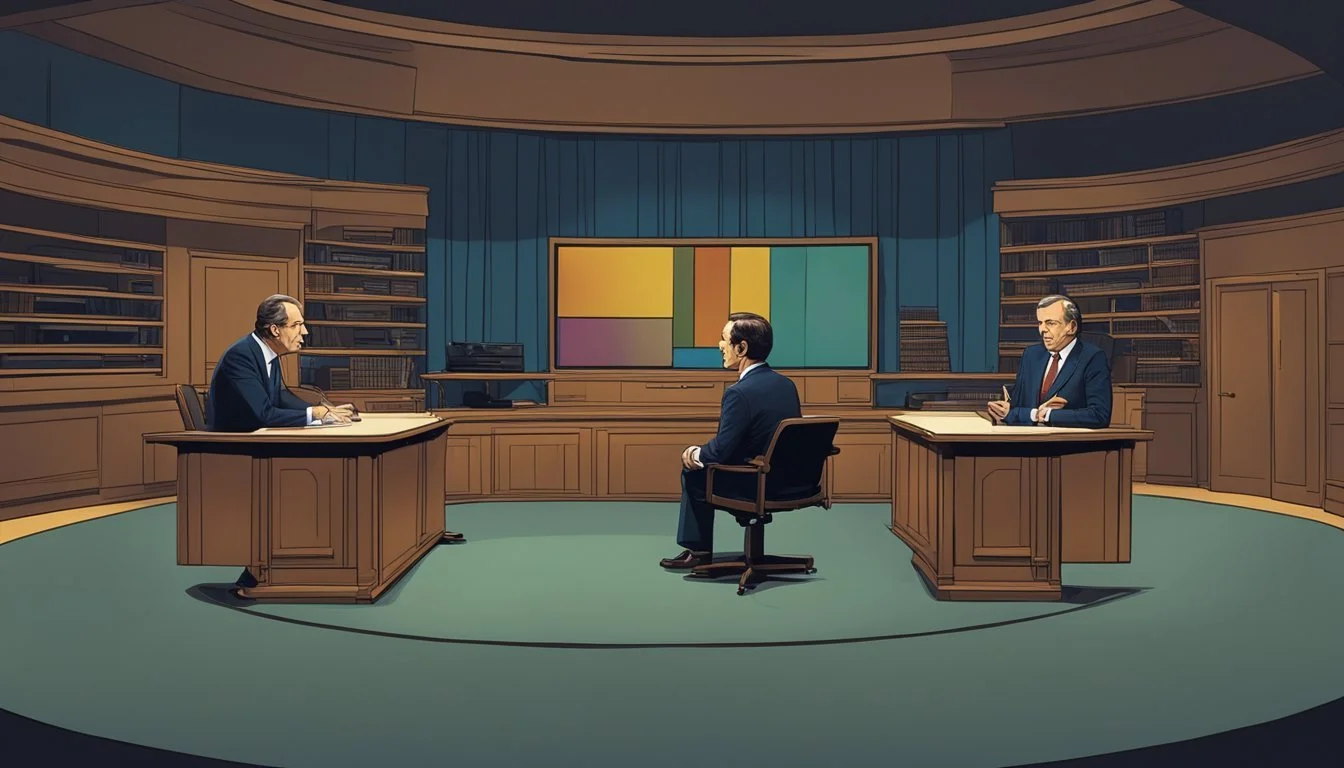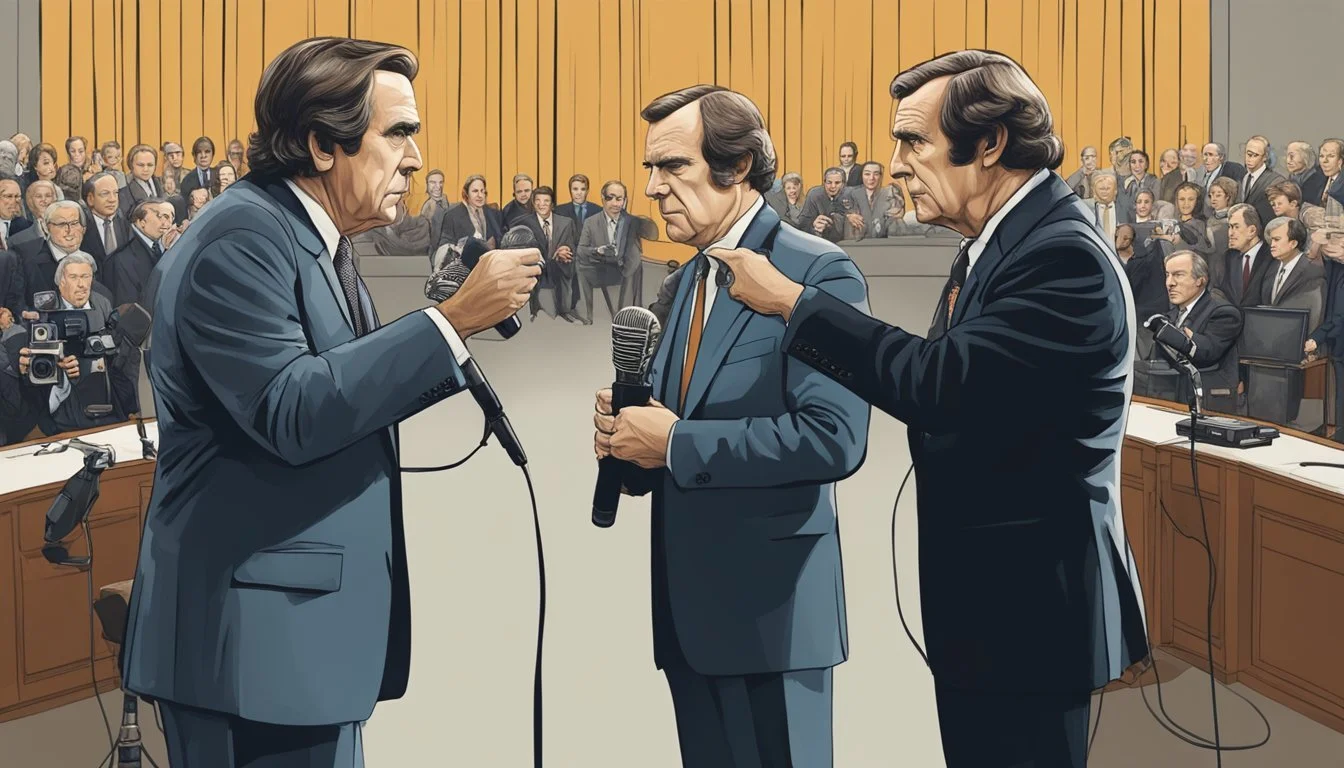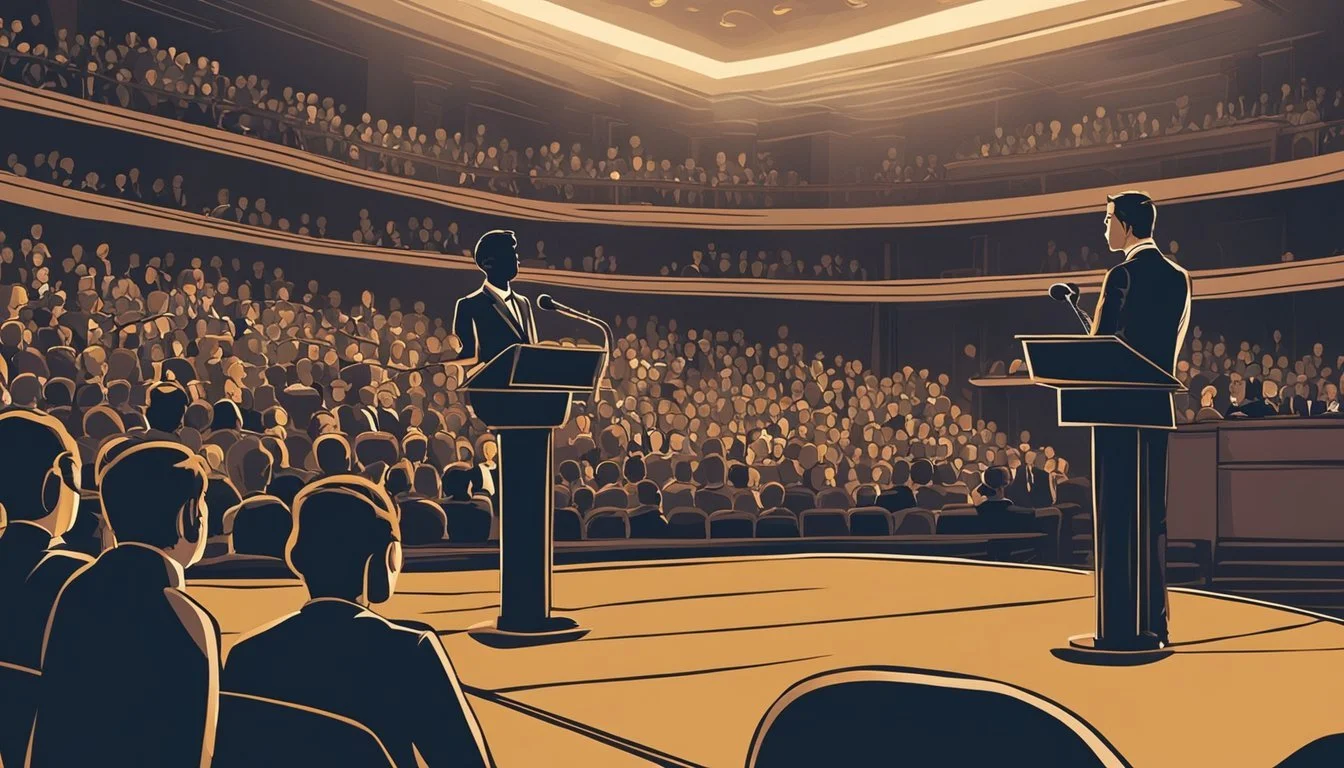Interview of the Century: The True Showdown in Frost/Nixon
A Pivotal Moment in Political History
In 1977, a television event captivated millions of viewers worldwide. David Frost, a British journalist, sat down with former U.S. President Richard Nixon for a series of interviews that would become known as "Frost/Nixon." These conversations, drawing over 45 million viewers, became the most-watched current affairs program in television history.
The interviews delved into Nixon's presidency, focusing heavily on the Watergate scandal that led to his resignation. Frost, known for his charm and wit, faced the challenge of extracting meaningful revelations from the notoriously guarded Nixon. The former president, seeking to rehabilitate his image, saw the interviews as an opportunity to present his side of the story to the American public.
The culmination of these interviews resulted in a dramatic moment of television history. Nixon, under Frost's persistent questioning, finally offered an apology for his role in the Watergate affair. This admission marked a turning point in public perception and cemented the "Frost/Nixon" interviews as a landmark moment in journalism and political discourse.
Backdrop of 'Frost/Nixon'
The 'Frost/Nixon' interviews emerged from a tumultuous period in American politics. Richard Nixon's presidency and its dramatic end set the stage for a historic televised encounter that captivated millions.
Historical Context of the Nixon Presidency
Richard Nixon's presidency began in 1969 amid social upheaval and the Vietnam War. He initially gained popularity by ending U.S. involvement in Vietnam and opening relations with China. However, the Watergate scandal overshadowed these achievements.
In 1972, burglars connected to Nixon's re-election campaign were caught breaking into the Democratic National Committee headquarters. The subsequent cover-up led to Nixon's resignation in 1974, making him the first U.S. president to resign from office.
Nixon retreated from public life for two years following his resignation. During this time, the nation grappled with the aftermath of Watergate and a crisis of confidence in government institutions.
Origin of the Frost/Nixon Interview Concept
David Frost, a British television personality, proposed the interview series in 1976. Frost saw an opportunity for a groundbreaking television event that could provide closure for the American public.
Nixon agreed to the interviews, partly motivated by a $600,000 payment and a share of the profits. He viewed the interviews as a chance to rehabilitate his image and present his side of the Watergate story.
The concept was risky for both parties. Frost, not typically known for hard-hitting journalism, faced skepticism about his ability to handle Nixon. Nixon, on the other hand, risked further damage to his legacy if the interviews went poorly.
Negotiations were intense, with debates over format, topics, and control of the final edit. The resulting agreement set the stage for a unique televisual confrontation between a disgraced former president and an ambitious interviewer.
Key Figures in 'Frost/Nixon'
The historic Frost/Nixon interviews featured two compelling central figures and crucial supporting players. Their complex personalities and motivations shaped the dramatic confrontation that captivated millions of viewers.
Profile of Richard Nixon
Richard Nixon, the 37th U.S. President, resigned in 1974 amid the Watergate scandal. By 1977, he sought to rehabilitate his image through televised interviews with David Frost. Nixon was known for his sharp intellect and political acumen, but also for his paranoia and resentment of perceived enemies.
During the interviews, Nixon displayed a mix of defensiveness and attempts at candor. He admitted mistakes in handling Watergate but denied criminal wrongdoing. His famous statement "I have impeached myself" revealed a man grappling with his legacy.
Nixon's performance was uneven - at times commanding, at others visibly uncomfortable. His responses provided new insights into Watergate and his presidency, though many viewers felt he never fully took responsibility for his actions.
Profile of David Frost
David Frost was a British broadcaster known for his charm and incisive interviewing style. Though seen as an unlikely match for Nixon, Frost's preparation and persistence produced revealing exchanges.
Frost invested significant personal resources to secure the Nixon interviews. He faced skepticism about his ability to effectively challenge the former president. However, Frost's disarming manner drew out Nixon in ways other journalists had not.
During tense moments, Frost pressed Nixon on Watergate and abuse of power. His question "Why didn't you burn the tapes?" led to one of Nixon's most candid admissions. Frost balanced hard-hitting questions with allowing Nixon space to explain himself at length.
Supporting Players: Reston and Brennan
James Reston Jr. served as Frost's Watergate researcher, providing crucial background and suggested questions. His deep knowledge of the scandal helped Frost navigate complex topics and challenge Nixon's evasions.
Jack Brennan, Nixon's post-resignation chief of staff, worked to protect his boss's interests. He negotiated interview terms and prepped Nixon, aiming to present him in the best possible light.
Reston and Brennan's behind-the-scenes efforts significantly impacted the interviews' substance and tone. Their opposing goals created additional tension as Frost sought to balance journalistic inquiry with Nixon's desire for image rehabilitation.
The Interviews
The Frost/Nixon interviews were a landmark event in television history, revealing the complexities of a disgraced president and the tenacity of a skilled interviewer. These sessions exposed Nixon's inner thoughts and tested Frost's mettle as a journalist.
Conducting the Interviews: Frost's Challenges
David Frost faced numerous obstacles in his quest to interview Richard Nixon. The British broadcaster had to secure funding independently, competing against major American networks. He also grappled with Nixon's team of advisors, who sought to control the narrative.
Frost's preparation was intense. He spent hours studying Watergate documents and consulting experts. His team developed strategies to keep Nixon engaged and off-guard.
The physical setup of the interviews presented its own challenges. Cameras were positioned to capture every facial expression and gesture, adding to the tension.
Nixon's Performance and Strategy
Nixon approached the interviews with a clear strategy: to rehabilitate his image and legacy. He prepared meticulously, working with a team of aides to anticipate questions and craft responses.
During the sessions, Nixon displayed a range of emotions. At times, he appeared confident and presidential. In other moments, he seemed defensive or evasive.
Nixon's strategy involved filibustering - giving long, detailed answers to run out the clock. He also attempted to steer conversations toward his foreign policy achievements.
The former president's demeanor shifted as the interviews progressed. Early confidence gave way to visible discomfort when pressed on Watergate.
Key Moments and Revelations
The most dramatic moment came when Nixon admitted to letting the American people down. This confession was unexpected and emotionally charged.
Nixon's statement that "when the president does it, that means it is not illegal" shocked viewers. It revealed his expansive view of executive power.
Frost's persistent questioning about the cover-up led to Nixon acknowledging mistakes in handling Watergate. This admission was crucial in the court of public opinion.
The interviews also touched on lighter subjects. Nixon's reflections on his childhood and political career provided a more human portrait of the controversial figure.
Impact of the Nixon Interviews on Journalism and Media
The Frost/Nixon interviews transformed political journalism and television. They set new standards for in-depth questioning of public figures and demonstrated the power of broadcast media to shape public opinion.
Legacy in Political Interviewing
The Nixon interviews elevated expectations for political interviews. Journalists began adopting more confrontational and persistent questioning styles. Networks invested in longer-form interviews that allowed for deeper exploration of complex topics.
TV interviewers like Barbara Walters and Mike Wallace gained prominence by emulating Frost's tough yet respectful approach. Politicians became more cautious and media-trained in response.
The interviews highlighted the importance of preparation and research. Frost's team spent months compiling questions and background information. This comprehensive approach became standard practice for major political interviews.
The Interviews and Television History
The Nixon interviews drew massive viewership, with 45 million Americans tuning in. This demonstrated television's unrivaled reach and influence in shaping public discourse on political issues.
The format broke new ground by dedicating multiple hours to a single subject. It paved the way for long-form TV journalism and documentary series examining historical events and figures in-depth.
Networks recognized the value of "event television" centered on newsworthy interviews. Similar high-profile sit-downs became regular occurrences, though few matched the impact of Frost/Nixon.
The interviews' success inspired more collaboration between British and American broadcasters on major journalism projects.
Cultural Representations
The Frost/Nixon interviews spawned several notable artistic interpretations. These adaptations brought the historic confrontation to new audiences through different mediums.
Peter Morgan's Play Adaptation
Peter Morgan's stage play "Frost/Nixon" debuted in 2006. It dramatized the behind-the-scenes tension and on-camera exchanges between the two men. Morgan's script focused on the psychological cat-and-mouse game between Frost and Nixon.
The play received critical acclaim for its sharp dialogue and compelling characterizations. It earned three Tony Award nominations, including Best Play.
Morgan's work laid the foundation for future adaptations. It brought renewed attention to the interviews decades after they aired.
Ron Howard's Cinematic Interpretation
In 2008, director Ron Howard adapted Morgan's play for the big screen. The film "Frost/Nixon" expanded on the theatrical version with a wider scope and more visual storytelling.
Howard's direction emphasized the high stakes of the interviews. He used cinematography and editing to heighten dramatic moments.
The movie received five Academy Award nominations. These included Best Picture and Best Director for Howard.
Performances by Sheen and Langella
Michael Sheen and Frank Langella starred as Frost and Nixon in both the play and film. Their portrayals were pivotal to the success of both adaptations.
Sheen captured Frost's charm and determination. Langella embodied Nixon's gravitas and vulnerability.
Langella's performance earned particular praise. He received an Oscar nomination for Best Actor.
The actors' chemistry brought depth to the adversarial relationship between interviewer and subject. Their performances helped audiences connect emotionally with the historical figures.
Analysis and Discussions
The Frost/Nixon interviews captivated audiences and sparked debates about historical accuracy and dramatization. Their impact on public perception and critical reception continues to be analyzed decades later.
Historical Accuracy and Dramatization
The Frost/Nixon interviews blended factual events with dramatic elements. While the core conversations occurred, some scenes were embellished for theatrical effect. The film portrays a late-night phone call between Frost and Nixon, which likely didn't happen in reality. This creative liberty aimed to heighten tension and explore the characters' psyches.
The movie compressed months of interviews into a more condensed narrative. It focused on key moments that best illustrated the power dynamics between the two men. Some dialogue was reconstructed based on recollections rather than verbatim transcripts.
Comparisons have been drawn to Truman Capote's "In Cold Blood," another work that blurred lines between fact and literary interpretation. Both pieces aimed to reveal deeper truths about their subjects through a mix of journalism and storytelling techniques.
Public and Critical Reception
The Frost/Nixon interviews drew an unprecedented television audience of over 45 million viewers. This massive reach cemented their place as a pivotal moment in broadcast history. The public's fascination with seeing a former president interrogated on camera was palpable.
Critics praised David Frost's interviewing skills and Nixon's complex portrayal. The exchanges were seen as a symbolic trial for Watergate, offering closure to a nation still grappling with the scandal. Some viewers found catharsis in Nixon's admissions of wrongdoing.
The film adaptation received critical acclaim, earning five Academy Award nominations. It was lauded for capturing the tension and high stakes of the original interviews. The performances of Frank Langella as Nixon and Michael Sheen as Frost were particularly highlighted for their nuanced portrayals.
Conclusion
The Frost/Nixon interviews left an indelible mark on television history. With over 45 million viewers, they became the highest-rated interview program ever broadcast in the United States.
These groundbreaking conversations reshaped public perception of Richard Nixon. They provided a platform for the former president to face tough questions about Watergate and his resignation.
David Frost's tenacious questioning style caught Nixon off guard. The resulting exchanges produced dramatic moments of television, including Nixon's near-confession of wrongdoing.
The interviews' legacy extends beyond their initial broadcast. They've inspired stage plays, films, and continued analysis of the complex relationship between media and politics.
Frost/Nixon remains a benchmark for political interviews. It demonstrated the power of television to hold leaders accountable and shape historical narratives.
The event's cultural impact persists. It continues to influence how journalists approach high-stakes interviews with political figures.






